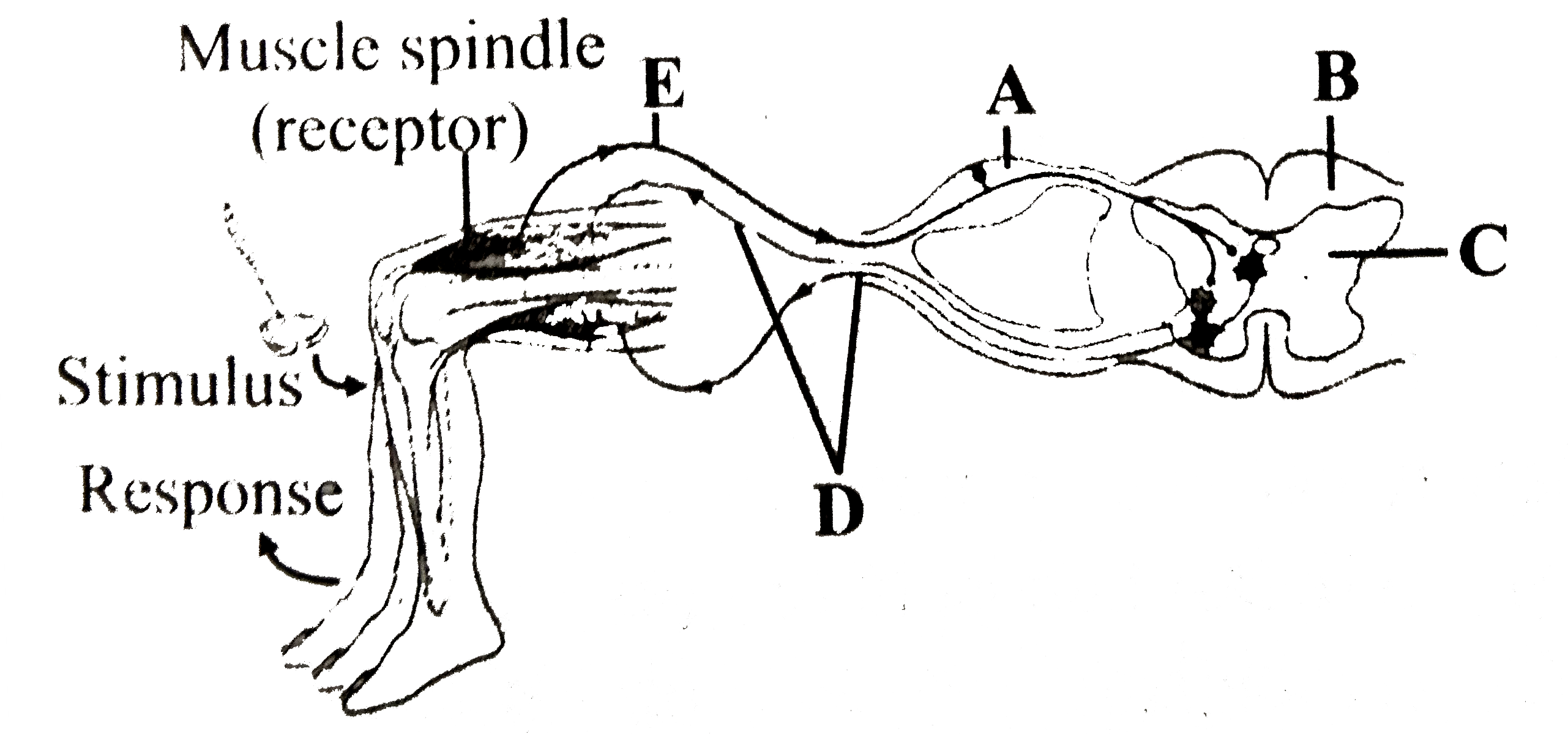Reflex action involves
medulla oblongata
cerebellum
optoc lobe
spinal cord
The correct Answer is:D
Step-by-Step Solution:
1. Understanding Reflex Action: Reflex action is an involuntary and rapid response to a stimulus. It is a protective mechanism that helps organisms respond quickly to harmful situations.
2. Identifying the Components: Reflex actions involve specific components:
- Stimulus: The event that triggers the reflex (e.g., touching a hot surface).
- Receptor: Sensory neurons that detect the stimulus.
- Afferent Pathway: The pathway that carries sensory information to the spinal cord.
- Integration Center: The spinal cord processes the information and generates a response.
- Efferent Pathway: The pathway that carries the response from the spinal cord to the effector (muscles).
- Effector: The muscle or gland that performs the response (e.g., pulling the hand away).
3. Analyzing the Options: The question provides four options regarding which part of the nervous system is involved in reflex actions:
- A. Medulla Oblongata: Involved in autonomic functions but not primarily in reflex actions.
- B. Cerebellum: Primarily involved in coordination and balance, not reflex actions.
- C. Optic Lob: Related to vision, not reflex actions.
- D. Spinal Cord: The correct answer, as it is the main center for processing reflex actions.
4. Conclusion: Based on the analysis, reflex actions primarily involve the spinal cord, which processes the sensory information and generates a motor response without the need for conscious thought.
Final Answer:
The correct answer is D. Spinal Cord.
---
- Stimulus: The event that triggers the reflex (e.g., touching a hot surface).
- Receptor: Sensory neurons that detect the stimulus.
- Afferent Pathway: The pathway that carries sensory information to the spinal cord.
- Integration Center: The spinal cord processes the information and generates a response.
- Efferent Pathway: The pathway that carries the response from the spinal cord to the effector (muscles).
- Effector: The muscle or gland that performs the response (e.g., pulling the hand away).
- A. Medulla Oblongata: Involved in autonomic functions but not primarily in reflex actions.
- B. Cerebellum: Primarily involved in coordination and balance, not reflex actions.
- C. Optic Lob: Related to vision, not reflex actions.
- D. Spinal Cord: The correct answer, as it is the main center for processing reflex actions.
The correct answer is D. Spinal Cord.
Topper's Solved these Questions
- NEURAL CONTROL AND COORDINATIONBOOK - AAKASH SERIESCHAPTER - NEURAL CONTROL AND COORDINATIONEXERCISE - EXERCISE-I (PERIPHERAL NERVOUS SYSTEM)
12 Videos
- NEURAL CONTROL AND COORDINATIONBOOK - AAKASH SERIESCHAPTER - NEURAL CONTROL AND COORDINATIONEXERCISE - EXERCISE-I (SENSORY RECEPTION AND PROCESSING)
33 Videos
- NEURAL CONTROL AND COORDINATIONBOOK - AAKASH SERIESCHAPTER - NEURAL CONTROL AND COORDINATIONEXERCISE - EXERCISE-I (CENTRAL NEURAL SYSTEM)
21 Videos
- MOLECULAR BASIS OF INHERITANCEBOOK - AAKASH SERIESCHAPTER - MOLECULAR BASIS OF INHERITANCEEXERCISE - Exercise-III (Previous AIPMT/NEET Questions) (AFMC)
5 Videos
- ORGANISMS AND POPULATIONSBOOK - AAKASH SERIESCHAPTER - ORGANISMS AND POPULATIONSEXERCISE - EXERCISE-III (PREVIOUS AIPMT/NEET QUESTIONS)
35 Videos
Similar Questions
Which of the following statements are true
(A) The entire process of involuntary response to a peripheral nervous stimulation is called reflex action.
(B)Information regarding changes in the environment is received by the CNS through the sensory organs which are processed and analysed.
(C) Reflex action occurs without conscious effort
(D) Reflex action requires the involvement of a part of the CNS
(E) Signals from sensory organs goes to spinal cord via ventral root. Choose the correct options from given below:-
View SolutionWhat is a reflex action? Give two examples of conditioned reflexes.
View Solution
Knowledge Check
The given diagrammatic representation of reflex action shows knee jerk reflex.

Identify the parts labelled as A to E and select the correct option.AABCDEDorsal root ganglionWhite matterGrey matterAfferent pathwayEfferent pathwayBABCDEDorsal root ganglionWhite matterGrey matterEfferent pathwayAfferent pathwayCABCDEVentral root ganglionGrey matterWhite matterEfferent pathwayAfferent pathwayDABCDEVentral root ganglionWhite matterGrey matterEfferent pathwayAfferent pathway
What are reflex actions? Give two examples. Explain a reflex arc
View SolutionSimplest reflex action in human is
View SolutionReflex action exhibited by
View SolutionVomiting is a reflex action and is controlled by the vomit centre. This is present in ________
View SolutionWhat do you mean by reflex action? What is its mechanism and significance ?
View SolutionWhat is reflex action? Write its types and two examples.
View SolutionWhich of the following reflex is involved to prevent
excessive inflation of the lungs?
View Solution
